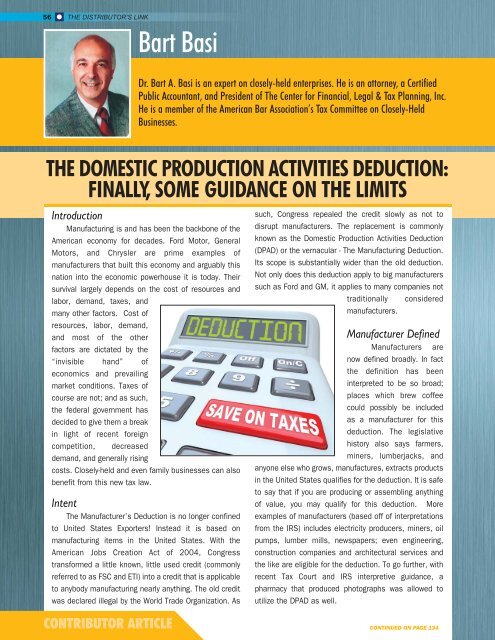WINTER 2016
Distributor's Link Magazine Winter Issue 2016 / Vol 39 No1
Distributor's Link Magazine Winter Issue 2016 / Vol 39 No1
Create successful ePaper yourself
Turn your PDF publications into a flip-book with our unique Google optimized e-Paper software.
56 THE DISTRIBUTOR’S LINK<br />
Bart Basi<br />
Dr. Bart A. Basi is an expert on closely-held enterprises. He is an attorney, a Certified<br />
Public Accountant, and President of The Center for Financial, Legal & Tax Planning, Inc.<br />
He is a member of the American Bar Association’s Tax Committee on Closely-Held<br />
Businesses.<br />
THE DOMESTIC PRODUCTION ACTIVITIES DEDUCTION:<br />
FINALLY, SOME GUIDANCE ON THE LIMITS<br />
Introduction<br />
Manufacturing is and has been the backbone of the<br />
American economy for decades. Ford Motor, General<br />
Motors, and Chrysler are prime examples of<br />
manufacturers that built this economy and arguably this<br />
nation into the economic powerhouse it is today. Their<br />
survival largely depends on the cost of resources and<br />
labor, demand, taxes, and<br />
many other factors. Cost of<br />
resources, labor, demand,<br />
and most of the other<br />
factors are dictated by the<br />
“invisible hand” of<br />
economics and prevailing<br />
market conditions. Taxes of<br />
course are not; and as such,<br />
the federal government has<br />
decided to give them a break<br />
in light of recent foreign<br />
competition, decreased<br />
demand, and generally rising<br />
costs. Closely-held and even family businesses can also<br />
benefit from this new tax law.<br />
Intent<br />
The Manufacturer’s Deduction is no longer confined<br />
to United States Exporters! Instead it is based on<br />
manufacturing items in the United States. With the<br />
American Jobs Creation Act of 2004, Congress<br />
transformed a little known, little used credit (commonly<br />
referred to as FSC and ETI) into a credit that is applicable<br />
to anybody manufacturing nearly anything. The old credit<br />
was declared illegal by the World Trade Organization. As<br />
CONTRIBUTOR ARTICLE<br />
such, Congress repealed the credit slowly as not to<br />
disrupt manufacturers. The replacement is commonly<br />
known as the Domestic Production Activities Deduction<br />
(DPAD) or the vernacular - The Manufacturing Deduction.<br />
Its scope is substantially wider than the old deduction.<br />
Not only does this deduction apply to big manufacturers<br />
such as Ford and GM, it applies to many companies not<br />
traditionally considered<br />
manufacturers.<br />
Manufacturer Defined<br />
Manufacturers are<br />
now defined broadly. In fact<br />
the definition has been<br />
interpreted to be so broad;<br />
places which brew coffee<br />
could possibly be included<br />
as a manufacturer for this<br />
deduction. The legislative<br />
history also says farmers,<br />
miners, lumberjacks, and<br />
anyone else who grows, manufactures, extracts products<br />
in the United States qualifies for the deduction. It is safe<br />
to say that if you are producing or assembling anything<br />
of value, you may qualify for this deduction. More<br />
examples of manufacturers (based off of interpretations<br />
from the IRS) includes electricity producers, miners, oil<br />
pumps, lumber mills, newspapers; even engineering,<br />
construction companies and architectural services and<br />
the like are eligible for the deduction. To go further, with<br />
recent Tax Court and IRS interpretive guidance, a<br />
pharmacy that produced photographs was allowed to<br />
utilize the DPAD as well.<br />
CONTINUED ON PAGE 134

















